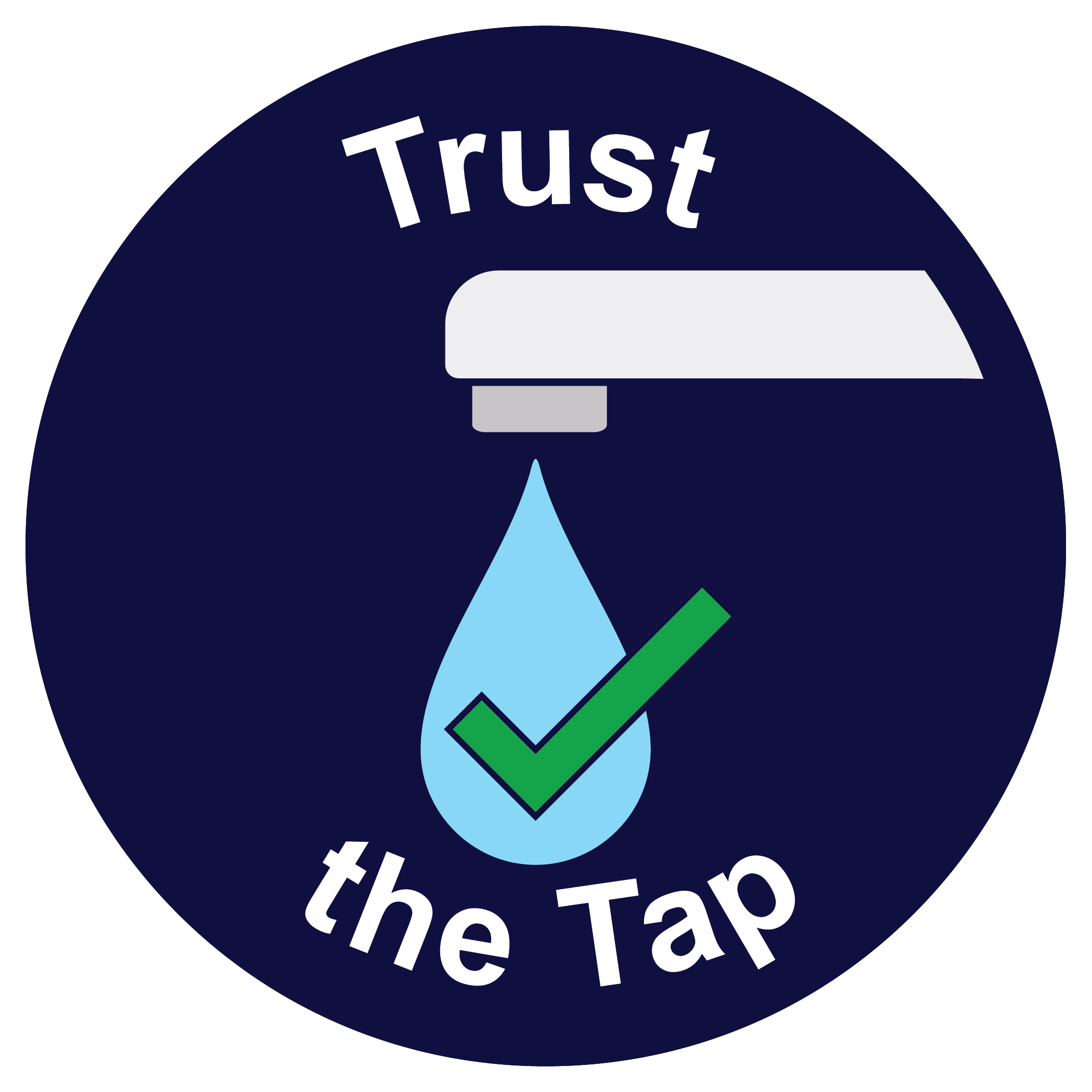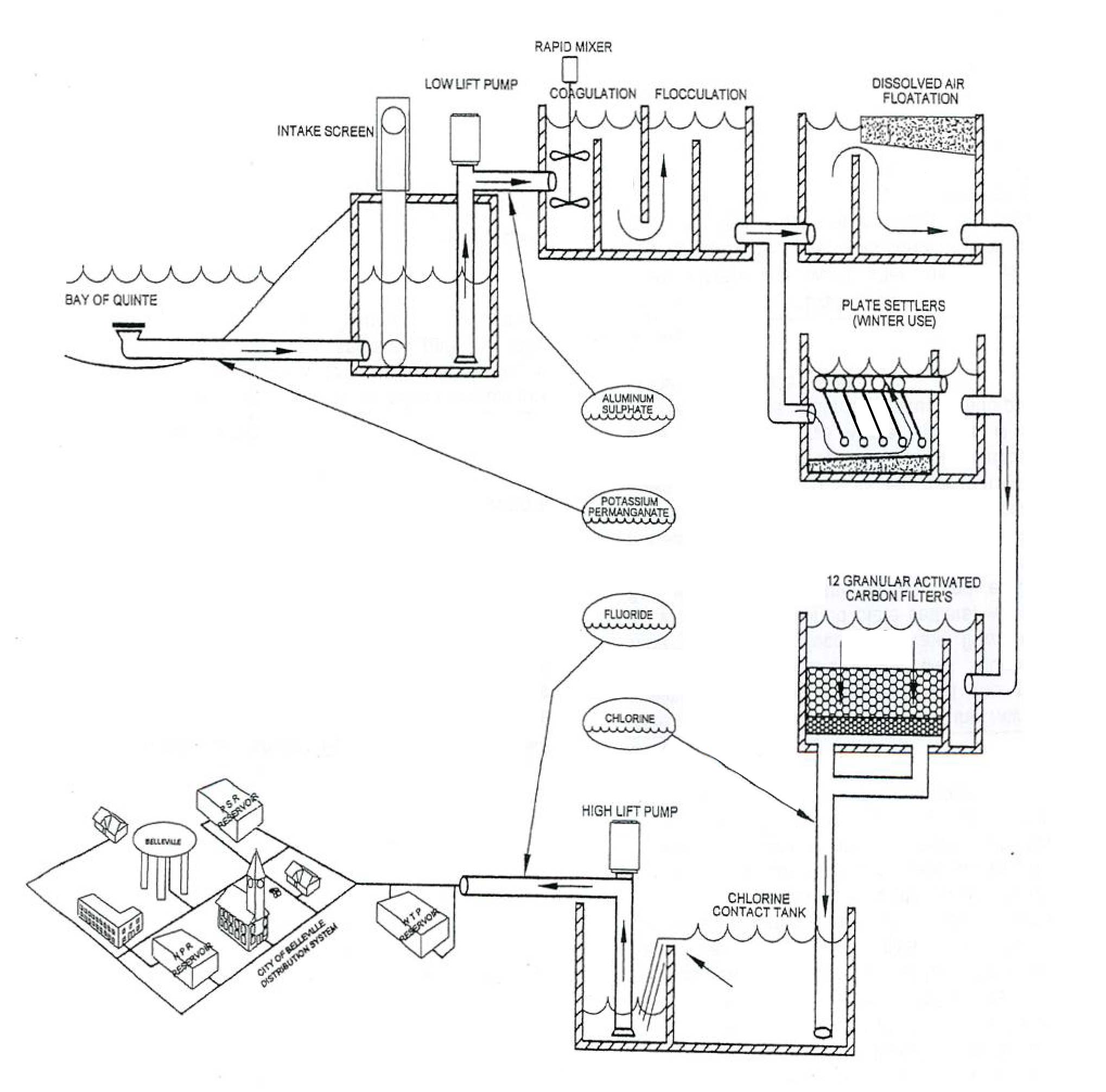Have you ever wondered where your tap water comes from? Or how we treat water to make it safe for you to drink? Read on to learn what happens to your drinking water before you turn on the tap.
Source Water Protection & Quality Management

Ensuring safe, reliable drinking water starts with protecting the bay and continues at the treatment plant. We work together with Quinte Conservation to protect the Bay of Quinte which is a vital habitat, recreational amenity and the source of municipal drinking water in Belleville. With highly trained operators and a strong Quality Management System in place, you can trust the tap when drinking from Belleville’s drinking water system.
You can play a role too! Keep yourself informed by understanding the risks. Blue-green algae (cyanobacteria) can be found in Ontario waterways, some forms of it produce toxins that may harm you or your pet. Learn what to look for and how to report it.
Our Water Treatment System
We have two water treatment plants that run 24 hours a day, 7 days a week. We treat most of Belleville's drinking water at the Gerry O'Connor Water Treatment Plant at 2 Sidney Street. It can treat up to 72 million litres of water each day. This is enough to fill Belleville's water tower twenty-four times. The most water ever used in a single day was 48.75 million litres, which is still far below the plant's capacity. The Point Anne Water Treatment Plant services a small neighbourhood in our community.
The Water Treatment Plant diagram shows how water travels from the Bay of Quinte through the water treatment plant and to our distribution system. Each stage of water treatment from raw water intake to disinfection is described in detail below.
Visit our digital interactive experience through our Water Treatment Plant!
Raw Water Intake
Raw or untreated water from the Bay of Quinte flows into the plant through two intake pipes. We add Potassium Permanganate to control taste and odour. This also stops zebra mussels from plugging the pipes. The water then travels through a screen to remove large debris like fish, weeds and shells.
Energy generated by four low lift pumps carries the raw water from bay-level up to the rapid mixing tank. Gravity takes over at this point. Water is carried through the rest of the plant until it gets to the high lift pump station.
Pre-Treatment and Clarification
Once the raw water reaches the rapid mixing tank, we add aluminum sulfate. This creates floc when it attaches to particles like dirt, sand, debris and micro-organisms (e.g., viruses, bacteria and algae).
What happens next depends on the season and the turbidity of the water. Turbidity reflects the amount of suspended solids in the water. This indicates water quality – the murkier the water, the higher the turbidity.
At this stage, we've removed up to 95% per cent of sediment from our drinking water.
In the winter
In the winter, ice protects the water in the bay from increased turbidity. This means that the raw water entering the treatment plant has fewer suspended solids and a normal sedimentation process can handle it. During the winter months, the flocculated water flows into two separate inclined plate settlers. The floc slides down the plates and is slowly removed from the bottom by vacuum. The cleaner water flows above the floc to the filters.
In the spring, summer and fall
In the spring, summer and fall when the bay is free of ice, raw water is exposed to weather conditions. This includes wind and rain, periods of warm weather, and algae growth. The water entering the plant has higher turbidity and is sent to the dissolved air flotation facility. In this facility, we inject air bubbles into the water. This helps the heavy floc rise to the surface. The cleaner water flows beneath the floc to the filters.
Filtration
Filtration is the final step that removes the remaining particulates from our drinking water. The water flows down through a 30-inch layer of Granular Activated Carbon and sand. This traps any remaining particulate and absorption removes tastes and odours.
Disinfection
The filtered water enters the contact chamber where we add chlorine to inactivate any microorganisms that make it passed the pretreatment process. We add a very small amount of chlorine to ensure the water remains drinkable as it travels through our distribution system.
We monitor water quality at each stage of the water treatment process. Before pumping treated water to the city, we add fluoride for the dental health of our residents.
Our Water Distribution System
After our treatment process, the water is safe to drink. Five high lift pumps move the water from the water treatment plant to our distribution system. The pumps push water through large pipes called transmission mains. They send large volumes to the water tower and three storage reservoirs. The water is then transported to smaller water mains that we use to deliver water to customers and fire hydrants.
Our distribution system serves over 40,000 residents and businesses every day through 224 kilometres of water mains in:
- the city's urban area
- Ward 2 (Thurlow)
- Prince Edward County, south of the Bay of Quinte
Wastewater Treatment Facility
The floc from the dissolved air flotation process and the sediment from the plate settlers is dewatered and concentrated in the on-site waste treatment facility. The clean water removed through the dewatering process is released back to the bay. We pump thickened sludge to the City's sewage treatment plant for further processing.
Water Financial Plan
In 2010, the City became an accredited water operating authority and received Municipal Drinking Water Licenses for both the Belleville and Point Anne Hamlet drinking water systems. These licenses are required by the Province of Ontario under the Safe Drinking Water Act (SDWA) and its associated regulation, O. Reg. 453/07 – Financial Plans. This legislation mandates that all municipal drinking water systems be licensed and operated by an accredited authority. As part of the initial licensing process, municipalities must develop and submit a Water Financial Plan that meets the requirements of O. Reg. 453/07.
The City’s most recent Water Financial Plan was completed in 2025, and is consistent with the annual water rate model presented to Council, the City’s Asset Management Plan, and the 10-Year Capital Plan. This documents provides a valuable framework for assessing the financial health of the City’s water system.

